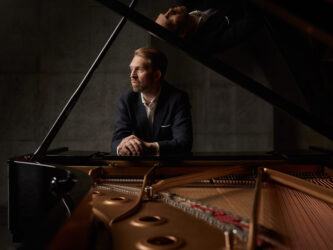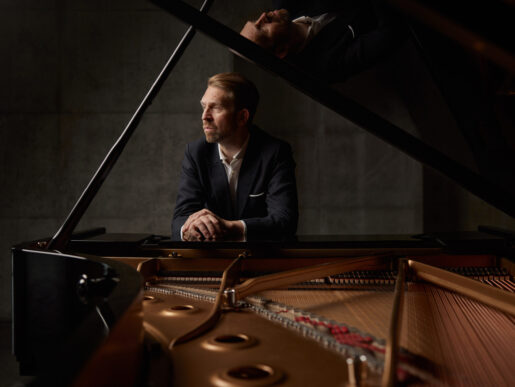 United States ‘Leif Ove Andsnes in Recital’: Leif Ove Andsnes (piano). Mandel Concert Hall at Severance Music Center, Cleveland, 27.3.2025. (MSJ)
United States ‘Leif Ove Andsnes in Recital’: Leif Ove Andsnes (piano). Mandel Concert Hall at Severance Music Center, Cleveland, 27.3.2025. (MSJ)

Grieg – Piano Sonata No.1 in E minor, Op.7
Geirr Tveitt – Piano Sonata No.29, Op.129, ‘Sonata Etere’
Chopin – Preludes, Op.28
Encore:
Debussy – ‘The Engulfed Cathedral’
Who cares?
It’s a hell of a question, and a pertinent one driven to the forefront by the current machinations of the unruly ruling powers in the United States. Major artists such as Christian Tetzlaff and Sir Andras Schiff have announced performance boycotts in protest of the situation. Others, such as Cleveland Orchestra music director Franz Welser-Möst, have cautioned against punishing the residents of the nation who are fighting against the rise of fascism and need the moral support of the arts. Pianist Leif Ove Andsnes took a similar view in announcing that he would be continuing with a planned US tour despite his concern over the current political situation. He has certainly received some criticism from detractors who would rather see him take a purist stance. Alas, life is never pure, and grandstanding by Tetzlaff and Schiff marks a position of privilege. Those of us in the midst of the situation have to take courage from music, knowing that some artists aren’t going to help us and feeling gratitude for those who will.
Kudos to Andsnes for coming to the US and having something to say, not that certain factions would recognize it. And only art could provide such a gnomic and compromised way to make a statement as the sole surviving piano sonata by Norwegian composer Geirr Tveitt (1908-1981). It is the sole surviving sonata because the vast majority of Tveitt’s compositions were lost in a devastating house fire that leveled his rural farm in western Norway in 1970. Some pieces survived because they had already been published, and others survived in broadcast recordings. In recent years, sophisticated modern technology has been applied to some of the burnt husks of manuscripts from the fire in order to slowly unwrap them with an electron microscope and use different kinds of light to read the charred layers. It is slow going, but a couple of works have already been rescued from oblivion.
Who cares? The question has to be asked because Tveitt was far from a successful composer in his day. He ended up living on a remote farm because of his estrangement from the musical mainstream of the mid- and late-twentieth century. His original foundation had been in the French impressionists, yet he later paired that to a deep interest in folk music of the Hardanger region of Norway – where the farm was – as well as a little modernistic flavor of Prokofiev and Bartók, and his own visionary ideas which seem to anticipate minimalism by decades. Yet, as the musical mainstream went toward serialism in the 1950s, Tveitt took a hard right turn towards a sort of folkloric nationalism. His Hundred Hardanger Tunes is a massive compilation of folksong settings that leave the likes of Grainger and Grieg in the quaint dust. Tveitt’s settings at times turn into breathtaking, magic-tinged visions, elusive and haunting. Out of six orchestral suites of such settings, four suites survived. There is also a separate piano suite. Before this recital, the orchestral suites were my only experience of Tveitt, but it was enough to make attending this concert essential.
No one knows how many piano sonatas there were. Thirty-something at the very least, all of which were lost in the fire, save one, the ‘Sonata Etere’ (‘Ethereal Sonata’), numbered No.29 by the composer. It was written in the mid-1940s, a time that is interesting to consider in relation to today: Tveitt had already begun his bitter retreat from the world, and the political situation in his land had isolated him even further. At that point, Norway had been reduced to the status of Nazi puppet state under Vidkun Quisling. Although Tveitt had taken a turn toward a sort of neopagan Nordic nationalism, he was far too esoteric and thorny to be embraced by the authoritarian crowd. One might even say Tveitt went so far right that he started coming around the back on the left side, writing music that anticipated the radical style of minimalism, at times restricting his tonal canvas to little more than pentatonic folk scales, albeit with major dissonant slashes across them when so moved. While it is folly to try and capture musical meaning in words, one could at least say that Tveitt’s music defies rules of either the left or right by being irrepressibly independent.
Before playing, Andsnes explained the rarity of Tveitt’s work, then demonstrated two folkloric (though original) tunes that the thirty-five-minute work is derived from. The first movement was an extended structure with the left-hand stabbing notes underneath (and occasionally above) a perpetual motion riff in the right hand that could come right out of a current John Adams piece. It was ethereal, as the title proclaims, but also unpredictable, at times ecstatic, at times violent, but most of all spellbinding. The second movement is a long set of variations, introduced with an extended technique. The pianist depresses the lower end of the keyboard with his arm, while brightly jabbing notes in the mid-range which end up in a hallucinogenic halo of sympathetic overtones from the open strings below them. It was a surreal, almost sci-fi kind of touch. The final movement, also a set of variations, ranged from lively, dancelike moments, to suspended visions. It ultimately closed with another use of the arm over the lower keys, while the right hand played a questioning gesture four times that floated off into an unanswerable haze.
I would like to hear the work again, preferably many times, because there is a lot going on. But my initial response was that even though you can quite clearly feel Tveitt was a bitter crank in full retreat from the world, he was also stepping up to an ancient shamanistic practice of pursuing visions through isolation, like a modern Merlin of the fjord country. I found the work stunning and can only thank Leif Ove Andsnes for his boldness and commitment in mastering the strange and glorious piece and – if I am guessing correctly – setting up this tour to share the discovery with us.
So, who cares? Well, one could infer that some of the potential audience members who might have come did not because Tveitt’s name is unfamiliar, and the Grieg Sonata and Chopin Preludes were not enough to fill Severance Music Center anywhere near capacity. And some of those who were in attendance were nonplussed. A man sitting in front of me (who had spent his time before the concert browsing far-right, ‘anti-woke’ social media sites on his phone), seemed at times quite absorbed by the piece and then, in other places, puzzled by it. At the end, he made a gesture with his hand as if he couldn’t believe the questioning ending. But the majority of the crowd had no doubts, going into a standing, cheering ovation. Despite the American fondness for standing ovations, it is by no means a given for a thorny, visionary sonata that few in the crowd could have known. It rather seemed that we were all caught up in the strange genius of the work, which Andsnes hypnotically conveyed.
The early Edvard Grieg sonata served as an overture, giving us a glimpse of the composer finding his way through the mainstream European language of his day toward his true, folk-influenced voice. The Chopin preludes were richly colored, though deployed with the characteristic restraint that underlies all of Andsnes’s performances. Capping the concert was a poised rendition of Debussy’s ‘The Engulfed Cathedral’, an encore that took the resonant influence of Chopin through the prism of French impressionism, feeling like a folkloric callback to the Tveitt piece.
In sum, it was a rather extraordinary recital that drove home the notion of the importance of art – and the value of less commonly heard voices – in a time and place when art and diversity are under dire threat. To answer that initial question: who cares? At least on this occasion, on a quiet evening in Cleveland, quite a few people rose to the occasion. Only time will tell if ethereal visions can survive Nero’s fiddling.
Mark Sebastian Jordan

This was a great concert, even if the audience was disappointing throughout.